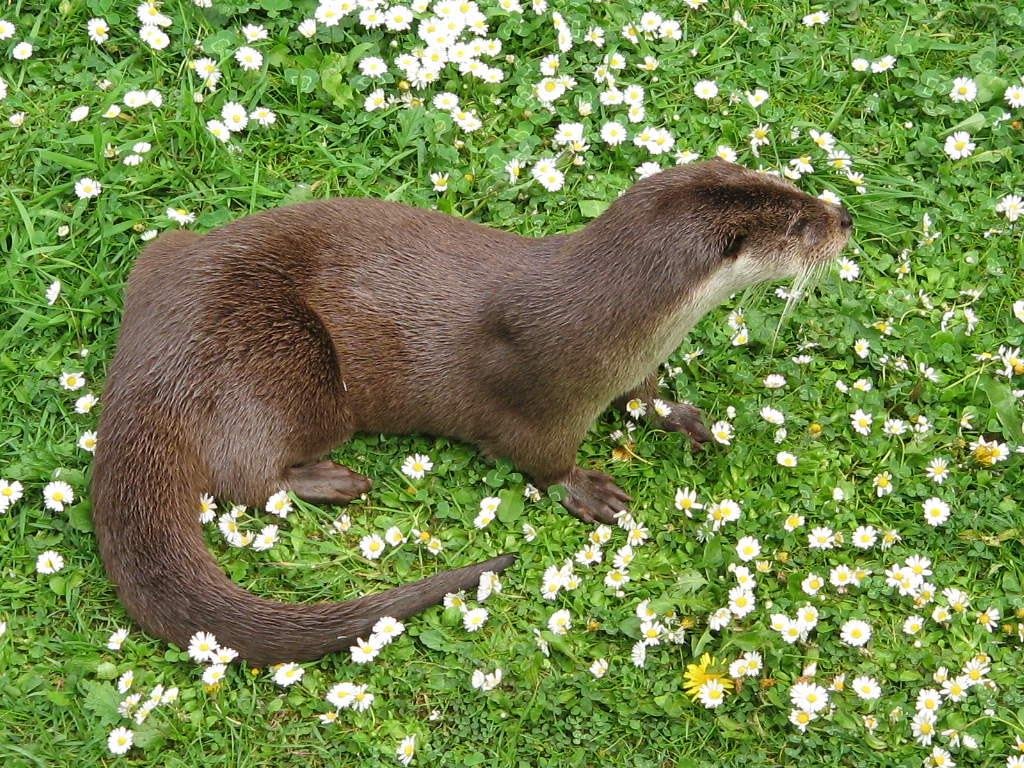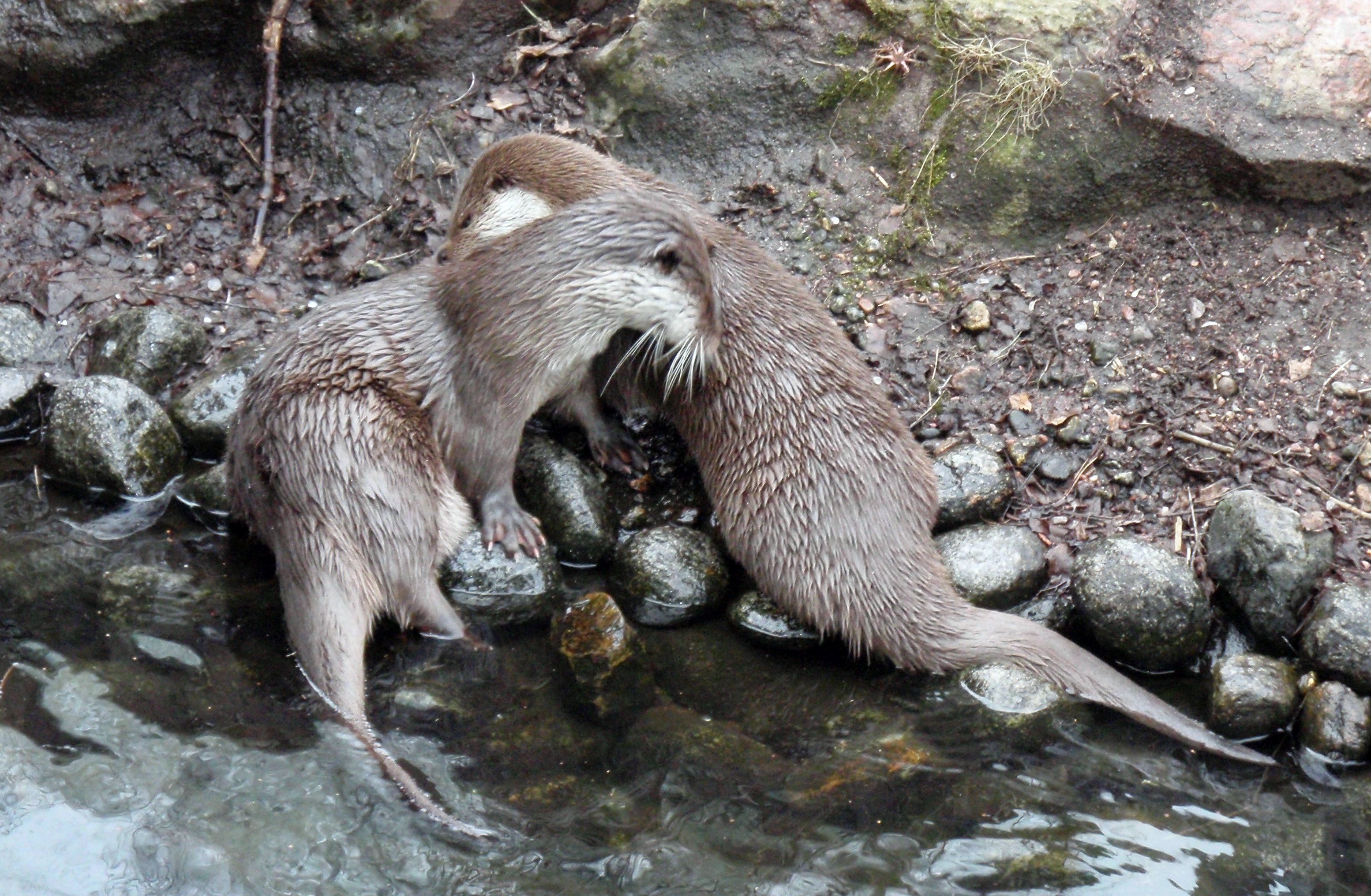|
Otters
Otters are carnivorous mammals in the Rank (zoology), subfamily Lutrinae. The 13 extant otter species are all semiaquatic, aquatic animal, aquatic, or Marine ecology, marine. Lutrinae is a branch of the Mustelidae Family (biology), family, which includes weasels, badgers, mink, and wolverines, among other animals. Otters' habitats include dens known as holts or couches, with their social structure described by terms such as dogs or boars for males, bitches or sows for females, and pups or cubs for offspring. Groups of otters can be referred to as a bevy, family, lodge, romp, or raft when in water, indicating their social and playful characteristics. Otters are known for their distinct feces, termed spraints, which can vary in smell from freshly mown hay to putrefied fish. Otters exhibit a varied life cycle with a gestation period of about 60–86 days, and offspring typically stay with their family for a year. They can live up to 16 years, with their diet mainly consisting of ... [...More Info...] [...Related Items...] OR: [Wikipedia] [Google] [Baidu] |
Pteronura
The giant otter or giant river otter (''Pteronura brasiliensis'') is a South American carnivorous mammal. It is the longest member of the weasel family, Mustelidae, a globally successful group of predators, reaching up to . Atypical of mustelids, the giant otter is a social species, with family groups typically supporting three to eight members. The groups are centered on a dominant breeding pair and are extremely cohesive and cooperative. Although generally peaceful, the species is territorial, and aggression has been observed between groups. The giant otter is Diurnality, diurnal, being active exclusively during daylight hours. It is the noisiest otter species, and distinct vocalizations have been documented that indicate alarm, aggression, and reassurance. The giant otter ranges across north-central South America; it lives mostly in and along the Amazon River and in the Pantanal. Its distribution has been greatly reduced and is now discontinuous. Decades of poaching for its ... [...More Info...] [...Related Items...] OR: [Wikipedia] [Google] [Baidu] |
Eurasian Otter
The Eurasian otter (''Lutra lutra''), also known as the European otter, Eurasian river otter, European river otter, common otter, and Old World otter, is a semiaquatic mammal native to Eurasia and the Maghreb. The most widely distributed member of the otter subfamily (Lutrinae) of the Mustelidae, weasel family (Mustelidae), it is found in the waterways and coasts of Europe, many parts of Asia, and parts of northern Africa. The Eurasian otter has a diet mainly of fish, and is strongly territorial. It is endangered in some parts of its range, but is recovering in others. Description The Eurasian otter is a typical species of the otter subfamily. Brown above and cream below, these long, slender creatures are well-equipped for their aquatic habits. Their bones show osteosclerosis, increasing their density to reduce buoyancy. This otter differs from the North American river otter by its shorter neck, broader visage, the greater space between the ears and its longer tail. However, the ... [...More Info...] [...Related Items...] OR: [Wikipedia] [Google] [Baidu] |
Aonyx
''Aonyx'' is a genus of otters, containing three species, the African clawless otter, the Congo clawless otter, and the Asian small-clawed otter. The word ''aonyx'' means "clawless", derived from the prefix '' a-'' ("without") and '' onyx'' ("claw/hoof"). Species Three species are currently recognised: Zoologists differ as to whether or not to include the Asian small-clawed otter in this genus, or in its own genus '' Amblonyx''. They also differ as to whether the Congo clawless otter is a species, or is conspecific Biological specificity is the tendency of a characteristic such as a behavior or a biochemical variation to occur in a particular species. Biochemist Linus Pauling stated that "Biological specificity is the set of characteristics of living organism ... with the African clawless otter. Notes References External links * * Carnivoran genera Otters Taxa named by René Lesson {{Carnivora-stub ... [...More Info...] [...Related Items...] OR: [Wikipedia] [Google] [Baidu] |
Siamogale
''Siamogale'' is an extinct genus of giant otter from the late Miocene-early Pliocene The Pliocene ( ; also Pleiocene) is the epoch (geology), epoch in the geologic time scale that extends from 5.33 to 2.58S. thailandica'' and '' S. bounosa'' from Thailand and '' S. melilutra'' from China. References Prehistoric mustelids[...More Info...] [...Related Items...] OR: [Wikipedia] [Google] [Baidu] |
Sardolutra
''Sardolutra ichnusae'' is an extinct species of otter from the Late Pleistocene of Sardinia. It was originally described as ''Nesolutra ichnusae''. It was a rather small species of otter, probably living in the sea. Among its characteristics is a relatively very large baculum The baculum (: bacula), also known as the penis bone, penile bone, ''os penis'', ''os genitale'', or ''os priapi'', is a bone in the penis of many placental mammals. It is not present in humans, but is present in the penises of some primates, ..., larger than in any living otter. The species probably evolved from a species of '' Lutra'', maybe '' L. castiglionis''. References Prehistoric mustelids Pleistocene carnivorans Otters Prehistoric mammals of Europe Monotypic prehistoric carnivoran genera Pleistocene genus extinctions Fossil taxa described in 1992 {{Paleo-carnivora-stub ... [...More Info...] [...Related Items...] OR: [Wikipedia] [Google] [Baidu] |
Megalenhydris
''Megalenhydris barbaricina'' is an extinct species of giant otter from the Late Pleistocene of Sardinia. It is known from a single partial skeleton, discovered in the '' Grotta di Ispinigoli'' near Dorgali, and was described in 1987. It was larger than any living otter, exceeding the size of South American giant otters (''Petrolutra''), which can reach two meters in length. The species is one of four extinct otter species from Sardinia and Corsica. The others are '' Algarolutra majori'', '' Lutra castiglionis''Pereira, E., and M. Salotti. "Cyrnolutra castiglionis, a new otter (Mustelidae, Lutrinae) from the Middle Pleistocene'Castiglione 3CG'deposit (Oletta, Corsica)." Comptes Rendus de l'Académie des Sciences, Séries IIA 331.1 (2000): 45-52/ref> and '' Sardolutra, Sardolutra ichnusae''. It is suggested to have ultimately originated from the much smaller European mainland species "''Lutra" simplicidens,'' which may be more closely related to '' Lutrogale'' than to modern '' Lu ... [...More Info...] [...Related Items...] OR: [Wikipedia] [Google] [Baidu] |
Enhydritherium
''Enhydritherium terraenovae'' is an extinct marine otter endemic to North America that lived during the Miocene through Pliocene epochs from ~9.1–4.9 Ma. ( AEO), existing for approximately . The ancestral lineage of ''Enhydritherium terraenova'' can be traced to Africa and Eurasia, but no clear route of migration can be determined according to Thompson et al. Taxonomy ''Enhydritherium terraenovae'' was named by Berta and Morgan in 1985 and is the genotype for this animal. Its type locality is the phosphate Palmetto Mine in Florida, which is in a Hemphillian marginal marine sandstone in the Upper Bone Valley Formation of Florida. Fossil distribution Fossil specimens were found in California (3 sites) and Florida (8 sites). In 2017, part of a jawbone was found in the Juchipila Basin, Zacatecas Zacatecas, officially the Free and Sovereign State of Zacatecas, is one of the Political divisions of Mexico, 31 states of Mexico. It is divided into Municipalities of Zacatecas, 5 ... [...More Info...] [...Related Items...] OR: [Wikipedia] [Google] [Baidu] |
Enhydriodon
''Enhydriodon'' is an extinct genus of otters known from Africa, Pakistan, and India that lived from the late Miocene to the early Pleistocene. It contains nine confirmed species, two debated species, and at least a few other undescribed species from Africa. The genus name means "otter tooth" in Ancient Greek and is a reference to its dentition rather than to the ''Enhydra'' genus, which includes the modern sea otter and its two prehistoric relatives. ''Enhydriodon'' belongs to the tribe Enhydriodontini (which also contains ''Sivaonyx'' and ''Vishnuonyx'') in the otter subfamily Lutrinae. The exact sizes and lengths of ''Enhydriodon'' species are unknown given the lack of complete fossils of it and most related fossil lutrines. Indian subcontinental species are estimated to be of weights similar to that of the extant sea otter, but African species are estimated to be heavier than extant lutrines. In particular, several species such as ''E. kamuhangirei'', ''E. dikikae'', and ''E. ... [...More Info...] [...Related Items...] OR: [Wikipedia] [Google] [Baidu] |
Lutrogale
''Lutrogale'' was proposed as generic name by John Edward Gray in 1865 for otters with a convex forehead and nose, using the smooth-coated otter ''L. perspicillata'' as type species. The genus also contains the following extinct and fossil A fossil (from Classical Latin , ) is any preserved remains, impression, or trace of any once-living thing from a past geological age. Examples include bones, shells, exoskeletons, stone imprints of animals or microbes, objects preserve ... species: *''L. cretensis'' – Cretan otter *''L. palaeoleptonyx'' *''L. robusta'' References {{Taxonbar, from=Q2899249 Otters Carnivoran genera Mammal genera with one living species Taxa named by John Edward Gray ... [...More Info...] [...Related Items...] OR: [Wikipedia] [Google] [Baidu] |
Satherium
''Satherium'' is an extinct genus of otters that lived in North America during the Pliocene and Pleistocene. Two species are known, '' Satherium piscinarium'' and ''Satherium ingens''. ''S. piscinarium'' was originally classified as a species of ''Lutra''. The giant otter of South America South America is a continent entirely in the Western Hemisphere and mostly in the Southern Hemisphere, with a considerably smaller portion in the Northern Hemisphere. It can also be described as the southern Subregion#Americas, subregion o ... is considered the closest living relative of this genus. References {{Taxonbar, from=Q19758218 Otters Prehistoric mustelids Prehistoric mammals of North America Pliocene mammals of North America Pleistocene mammals of North America Prehistoric mammal genera ... [...More Info...] [...Related Items...] OR: [Wikipedia] [Google] [Baidu] |
Lutra
''Lutra'' is a genus of otters, one of seven in the subfamily Lutrinae. Taxonomy and evolution The genus includes these species: Extant species Extinct species *†'' Lutra affinis'' *†'' Lutra bressana '' *†'' Lutra bravardi'' *†'' Lutra castiglionis'' *†'' Lutra euxena'' *†'' Lutra fatimazohrae'' *†'' Lutra franconica'' *†'' Lutra hearsti'' *†'' Lutra palaeindica'' *†'' Lutra simplicidens'' *†'' Lutra trinacriae'' The genus most likely evolved in Asia during the late Pliocene epoch; the oldest fossil belonging to the genus is of the species ''L. palaeindica'', and dates from the late Pliocene. Habitat ''Lutra'' species are semiaquatic mammals, so they are well-adapted to both water and land. They prefer shallow, narrow areas of streams surrounded by mature trees and with rocks, especially where weirs reduce the flow of the water, as well as attract fishes. They seem to tolerate roads and residential and agricultural areas, but only moderate hu ... [...More Info...] [...Related Items...] OR: [Wikipedia] [Google] [Baidu] |
Lontra
''Lontra'' is a genus of otters from the Americas. Species These species were previously included in the genus ''Lutra'', together with the Eurasian otter The Eurasian otter (''Lutra lutra''), also known as the European otter, Eurasian river otter, European river otter, common otter, and Old World otter, is a semiaquatic mammal native to Eurasia and the Maghreb. The most widely distributed member o ..., but they have now been moved to a separate genus. The genus comprises four living and one known fossil species: Extant species Extinct species References Otters Mammals of the Americas Carnivoran genera Taxa named by John Edward Gray {{Carnivora-stub ... [...More Info...] [...Related Items...] OR: [Wikipedia] [Google] [Baidu] |






